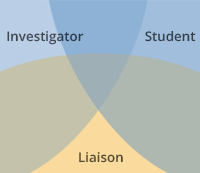Liaison Best Practices
Introduction
The liaison role has become a powerful tool for maximizing the value of SRC membership. Liaisons are member company employees who sign up on one or more SRC research efforts. By doing so, they provide a helping hand, and reap benefits for their companies in terms of early transfer of useful findings and technology.

A typical research task or theme will have at least one of each of the following three roles.
- Investigator – principal investigator (PI), co-PI, task or theme leaders, and other faculty researchers managing a project at some level.
- Student – participating on SRC research tasks or themes as part of their educational experience.
- Liaison – guiding the research, mentoring students, and creating pathways for technology transfer.
Best Practices
1. Establish alignment with your company management.
Different companies leverage liaisons in different ways. It is helpful if you understand what your company's expectations are when you decide to participate in the program. Take a look at the history of the liaison program at your company, and talk to prior participants. You want to agree with your management on the level of resources available: time, travel, and in-kind support.
2. Aim to be as engaged as possible.

What we have learned is that the more engaged you are, the better the research and the more value your company will receive from the program and your membership. While any level of engagement is useful—being somewhat engaged is better than not being engaged—the more time you are able to devote to the assignment, the more you and everyone else will benefit.
While there are many different ways to participate as a liaison, it’s useful to think of engagement as three tiered options, as outlined below.
| Somewhat Engaged | Moderately Engaged | Highly Engaged |
|
|
|
Among the factors to consider in the determining the right level of engagement are (a) the number of other liaisons attached to the research task or theme, and (b) the ability of the research team to engage with each liaison.
3. Reach and maintain an understanding with the investigator.
As early as possible, establish your level of engagement. Help the investigator understand what you need in order to justify your commitment to the project. Be specific and clear when giving input about proposed adjustments to the research direction. How much freedom do you have to interact with students? Attend research reviews and coordinate with your company's relevant TAB member to ensure good comments and appropriate ratings are captured at reviews.
4. Have a communications plan with the research team.
While best results are gained from open pathways of communications among all participants, it is helpful to plan and structure interactions. If time allows for teleconferences (every 4 to 6 weeks), and regular visits to the university, these should be scheduled in advance. Perhaps encourage a student to own the scheduling and present the work. Plan meet ups at conferences if both students and liaison are attending.
5. Understand the needs of the research team.
Approach the relationship with any context you can gather from other liaisons, and prior relationships. Keep in mind that SRC funding doesn't cover capital expenditures, so a liaison will want to discover what unmet needs exist. Do they need samples? Metrology? Do they need technical advice? Training? Do they need to understand the relevance of the research, or some new focus or direction? What about the students? Is a student looking for an internship, a job, a letter of support, some industry exposure?
6. Help the research team obtain what they need to succeed.
Respond to the team's need with resourcefulness. Try to develop an expanding network of support at your company. If you can't provide the resource directly, perhaps another group can help. Sometimes this involves bartering with resources you do have.
7. Reach out to the SRC community inside and outside your company.
Beyond including the relevant TAB member at your company as a one of your go-to resources for guidance, connect with liaisons from your company and other companies, particularly those who have been identified as best-in-class—that is, past winners of SRC's Outstanding Liaison Award.
TECHCON is a great place to meet the larger SRC community and to network with other liaisons. Encourage your colleagues to attend for the technology transfer and recruiting opportunities.
8. Create opportunities for technology transfer.
Without technology transfer, university research lacks impact. Liaisons can create a rich, multi-faceted environment for technology transfer. Here are some of the tech transfer opportunities that prior liaisons have discovered.
|


